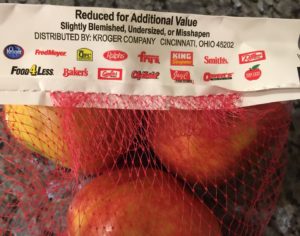“Six garbage trucks of food are lost every second”
- “Farmers, Consumers Lose $15 Billion to Food Waste”
- “If food waste was its own country, it would be the third largest country, behind China and the U.S.”
Every week, new stories, studies or presentations are cited, heard or quoted about food waste. Headlines make us think. But do they motivate us to change our behavior? Like obesity, we talk about it, recite amazing statistics, and say we “have to do something about it”! But where do we start?
Besides evaluating our own food buying and preparation habits, we need to view food as part of the total sustainability cycle. As consumers, we want to know every step of our food production from farm to table. It is with this same passion that we need to understand our food waste situation.
Food Waste Cycle
Growing up on a farm, I don’t remember that we wasted much food. We grew the majority of vegetables we ate along with chickens, eggs and milk. What was not consumed fresh was frozen and canned. Grocery store purchases were planned with a list in hand to supplement what we grew. Our fruit was a combination of canned, fresh and the “precious” peaches or strawberries purchased in season and frozen for future consumption. Of course, expiration dates on milk were never a problem when you are getting it straight from the cow.

Regardless of income levels or purchasing habits, food waste is inevitable but we need to do better. What we forget is the impact of our habits goes beyond our kitchens.
Beyond the Kitchen
During the same time period of the Penn State study release, Dairy Herd Management2 highlighted a story about the $15 billion lost due to food waste from farm food handling and growing practices, retail expectations and “at home” habits. As reported by the World Resources Institute (WRI), 19% of all fertilizer input costs by farmers are lost due to food waste.2 From a farming perspective, understanding the causes of food loss is the first step. According to WRI, the best ways to reduce food loss in the field are (1) implementing better food handling practices by workers to reduce the initial bruising of produce, (2) harvesting crops at the right time, and (3) implementing better weather data monitoring on rainfall and temperature. We know none of us can control “Mother Nature” but having better data to migrate the risks is important.
As mentioned in my blog “Food Snobs = Food Waste,” the connection of farm to retail and ultimately the consumer becomes a real barrier to addressing food waste. Unharvested produce is left in the fields when standards are not met for customers…meaning us!
At the recent “Trust in Food” Conference sponsored by the Farm Journal Foundation, Christine Daugherty, Vice President of Global Sustainable Agriculture for PepsiCo. noted that “change throughout the food cycle is critical” if the U.S. is going to have a sustainable food system. She mentioned that at PepsiCo, the food system is viewed through the lens of “how we grow food, make food and consume food,” and how we change to eliminate the “six tons of garbage trucks of food lost every second.”
Changing Our Habits

- First of all, be mindful that the negative economic and environmental consequences surrounding food waste are real.
- Second, grocery shop with a list and think about quantity of food for size of household. For example, it’s difficult for a two-person household to eat all the salad greens in the largest plastic container before spoilage occurs (speaking from experience). And remember, “fresh” canned and frozen fruit and vegetables provide equal nutrition value without the waste!
- Finally, view leftovers or extra ingredients as opportunities to be creative or freeze for later uses (like using bananas for bread or smoothies and using cooked vegetables for soup). For more creative ideas to reverse the waste, check out resources from registered dietitians like Elizabeth Ward, MS, RD, or the Academy of Nutrition and Dietetics or the USDA.
Food waste is complicated and solutions are not easy but we all can work together — one family, one kitchen, one farm at a time.
References
1. The Shocking Amount of Food U.S. Households Waste Each Year, Forbes.com, January 26, 2020
2. Farmers, Consumers Lose $15 Billion in Food Waste, AgWeb, January 27, 2020

 “Six garbage trucks of food are lost every second”
“Six garbage trucks of food are lost every second”